Dyspepsia Drugs Market Size
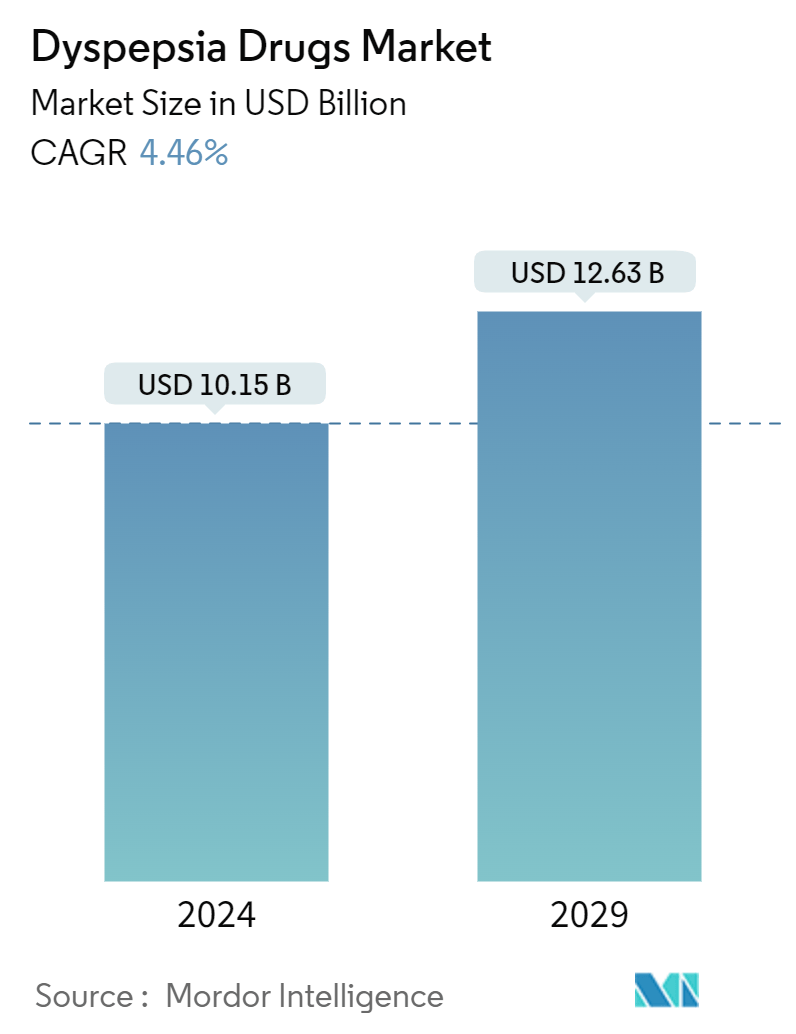
| Study Period | 2019 - 2029 |
| Market Size (2024) | USD 10.15 Billion |
| Market Size (2029) | USD 12.63 Billion |
| CAGR (2024 - 2029) | 4.46 % |
| Fastest Growing Market | Asia-Pacific |
| Largest Market | North America |
| Market Concentration | Low |
Major Players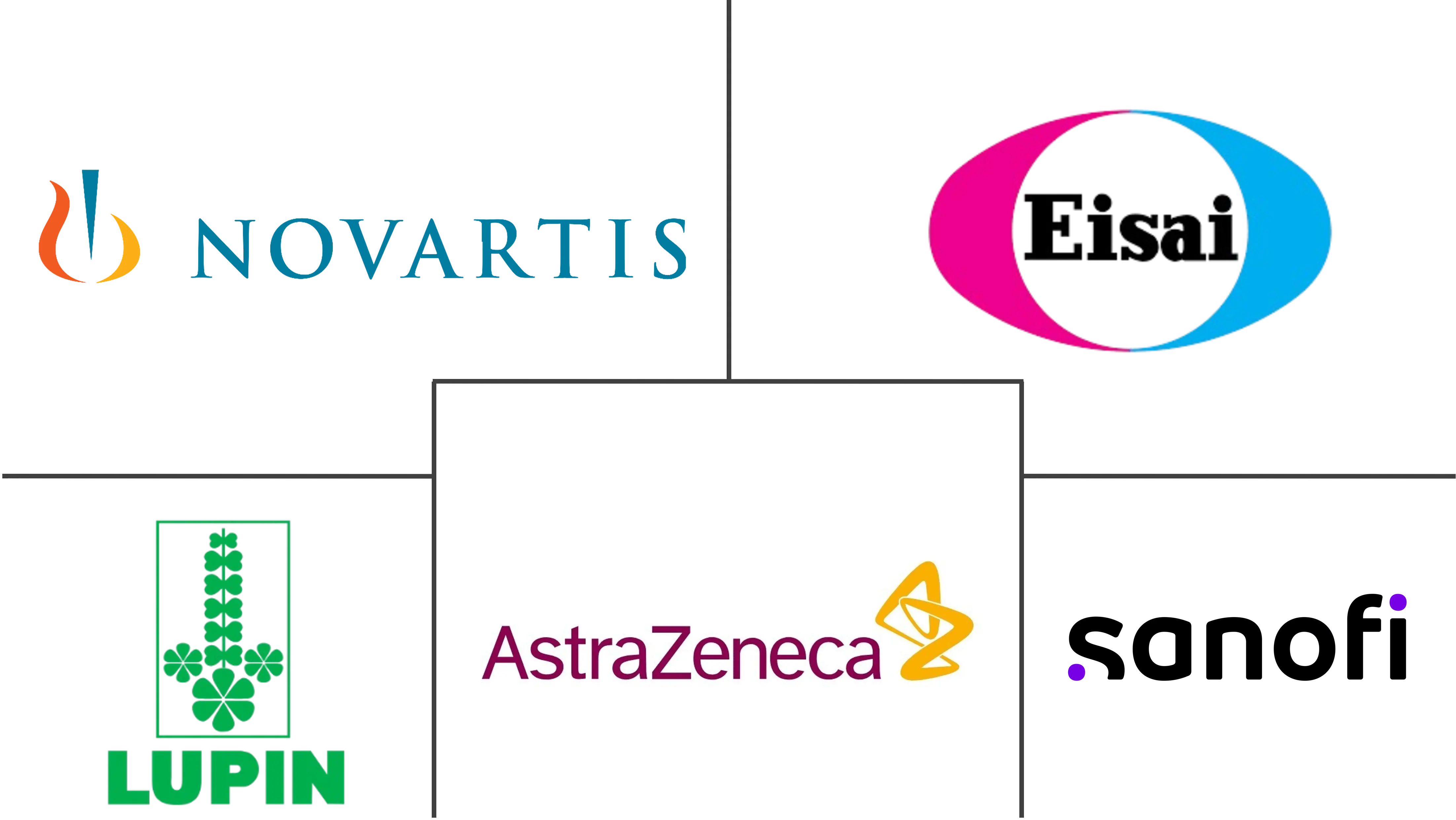
*Disclaimer: Major Players sorted in no particular order |
Dyspepsia Drugs Market Analysis
The Dyspepsia Drugs Market size is estimated at USD 10.15 billion in 2024, and is expected to reach USD 12.63 billion by 2029, growing at a CAGR of 4.46% during the forecast period (2024-2029).
Dyspepsia or indigestion is characterized by pain or discomfort in the upper abdomen, commonly accompanied by nausea, bloating, belching, and sometimes vomiting. The primary driver for the market growth is the rising cases of indigestion or dyspepsia and growing awareness among people related to its treatment at an early stage to prevent severe gastrointestinal diseases, thereby propelling the market growth. For instance, as per a study published by Medicine Journal in October 2023, the prevalence of functional dyspepsia (FD) was considerably higher in low- and middle-income countries, with 37.9%, compared to high-income countries at 10% in 2022. It further concluded that Sudan obtained the highest prevalence, 44.3%, then Egypt, 41.4%, while the lowest was in Algeria, 25.7%, in 2022. Thus, the high prevalence of dyspepsia among low-middle-income countries is anticipated to be a lucrative growth opportunity for dyspepsia treatment during the forecast period.
In addition, several studies emphasize that dyspepsia is the initial symptom of gastroesophageal reflux disease (GERD). For instance, according to a study published in the Journal of Gastroenterology and Hepatology in February 2024, it was concluded that 41.5% of GERD patients have symptoms of dyspepsia, and an overlap between GERD and non-diagnosed dyspepsia was found in 50% of GERD patients. Thus, the high burden of GERD indicates the high burden of untreated dyspepsia, which causes GERD in its later phase. Such studies highlight that as the GERD burden grows, so does the demand for dyspepsia drugs, contributing to market growth during the forecast period.
Also, poor lifestyle choices such as smoking and alcohol consumption lead to higher incidences of acidity and dyspepsia over time, which is expected to register significant growth during the forecast period. For instance, according to an article updated by the National Center for Biotechnology Information in May 2024, tobacco smoking is considered an etiological factor of reflux esophagitis or acid reflux, and it is regarded as a significant risk factor for acid reflux over the age of 50. Smoking causes functional abdominal pain and bloating, an essential symptom of dyspepsia. Therefore, smoking is associated with a high incidence of acidity, which is expected to boost the demand for dyspepsia drugs during the forecast period.
Additionally, the rising geriatric population is more prone to gastric indigestion problems, which are ultimately associated with dyspepsia. For instance, as per a study published by the Gastrointestinal Disorders Journal in March 2024, the estimated prevalence of dyspepsia in the elderly population ranges from 9% to 25%. Therefore, with the increasing geriatric population related to acid reflux diseases, the market is expected to experience growth during the forecast period.
Therefore, owing to factors such as poor lifestyle choices such as smoking and the increasing incidence of acidity, the market is expected to witness growth during the forecast period.
However, side effects associated with the dyspepsia drugs are expected to restrain the market's growth.
Dyspepsia Drugs Market Trends
The H2 Antagonist Segment is Expected to Witness Growth During the Forecast Period
H2-receptor antagonists, or H2-blockers, reduce gastric acid secretion by competitively inhibiting histamine. They play an essential role in the treatment of acid-related disorders such as dyspepsia and peptic ulcers. Some examples of H2 antagonists prescribed for reducing stomach acid are famotidine, cimetidine, nizatidine, and ranitidine.
The segment is expected to grow during the forecast period owing to the high availability and effectiveness of H2 blockers, driving its adoption rate among the patient population. For instance, the updated article published by SingleCare in June 2024 mentioned that H2 antagonists are commonly used for dyspepsia symptoms such as heartburn, and H2 antagonists include Tagamet (cimetidine), Axid (nizatidine), and Pepcid (famotidine). It further stated that H2 antagonists are relatively cost-effective, especially when patients choose generic versions for treatment.
Similarly, as per an article published by the Pharmacy Network in January 2024, H2RAs such as famotidine and nizatidine have a rapid onset of action and are suitable for people with milder, intermittent symptoms of indigestion or dyspepsia. Thus, the cost-effectiveness of the drugs is anticipated to fuel the segment growth during the forecast period.
Also, the increasing strategic initiatives by industry players to enhance their offerings are the key factors influencing the growth of H2 antagonist drugs in the market, which could drive segment growth. For instance, in June 2022, Glenmark Pharmaceuticals Ltd acquired specific over-the-counter drugs from Wockhardt Ltd in the United States through its wholly-owned subsidiary Glenmark Pharmaceuticals Inc. This acquisition notably encompassed the approved abbreviated new drug applications (ANDAs) for famotidine tablets (10 mg and 20 mg), indicated for indigestion, heartburn, and ulcer prevention in the gastrointestinal tract. Such developments are anticipated to boost segment growth during the forecast period.
Therefore, the abovementioned factors, such as high availability, rapid onset of action, and strategic initiatives of market players to expand their offerings, contribute to driving the H2 antagonist segment growth during the forecast period.
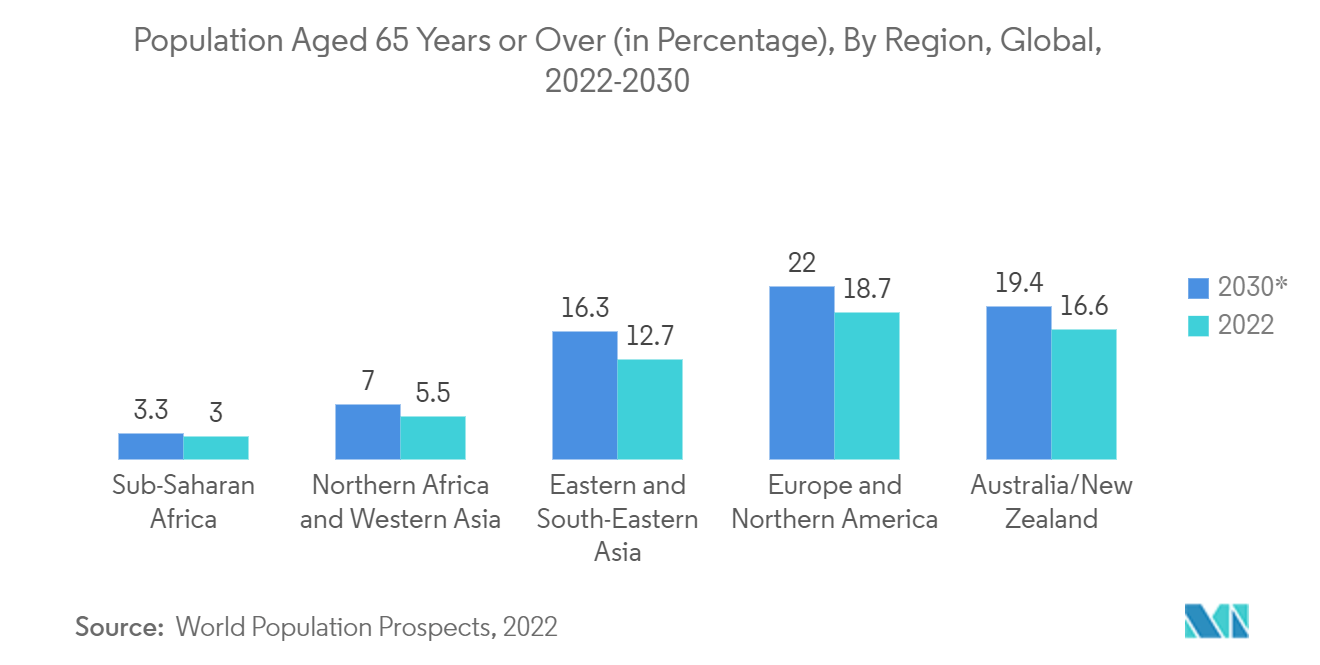
North America is Expected to Hold a Significant Market Share During the Forecast Period
North America is expected to hold a significant market share owing to factors such as the high burden of indigestion cases leading to dyspepsia, poor lifestyle, and product launches, along with the high concentration of market players in the region.
People's poor lifestyles, such as smoking and alcohol consumption, are associated with symptoms of dyspepsia, which is expected to propel the market growth in the region. For instance, according to the 2023 National Youth Tobacco Survey data in November 2023, an estimated 2.80 million middle and high school students in the United States reported using any tobacco product in 2023. The high percentage of adults with smoking habits is expected to create an opportunity for market players to manufacture dyspepsia drugs on a large scale, which will significantly increase market growth in the region during the forecast period.
Moreover, the proportion of gastroscopies performed for diagnosis of dyspepsia among patients over 65 years old with no alarm symptoms or clinically appropriate indications is further driving the demand for its treatment. For instance, as per a study published by the Journal of the Canadian Association of Gastroenterology in February 2024, among the 1,241 outpatient gastroscopy charts sampled on patients aged 18-65 years, 18.2% were diagnosed with alarm symptoms of dyspepsia. Such studies highlight the surging need for therapeutic measures for dyspepsia treatment.
Additionally, strategic initiatives such as approvals, launches, and partnerships by market players to expand the dyspepsia offerings are expected to expand the market growth in the country. For instance, in June 2022, Zydus Lifesciences received approval from the United States Food and Drug Administration (FDA) to market the famotidine 20 mg and 40 mg tablets in the American market. It is a histamine H2 receptor blocker that reduces acid secretion in the stomach. Such regulatory approvals are anticipated to expand treatment options for dyspepsia across the region.
Therefore, the market is expected to grow in North America due to the factors mentioned above, such as poor lifestyle leading to indigestion and new product approvals and launches by market players.
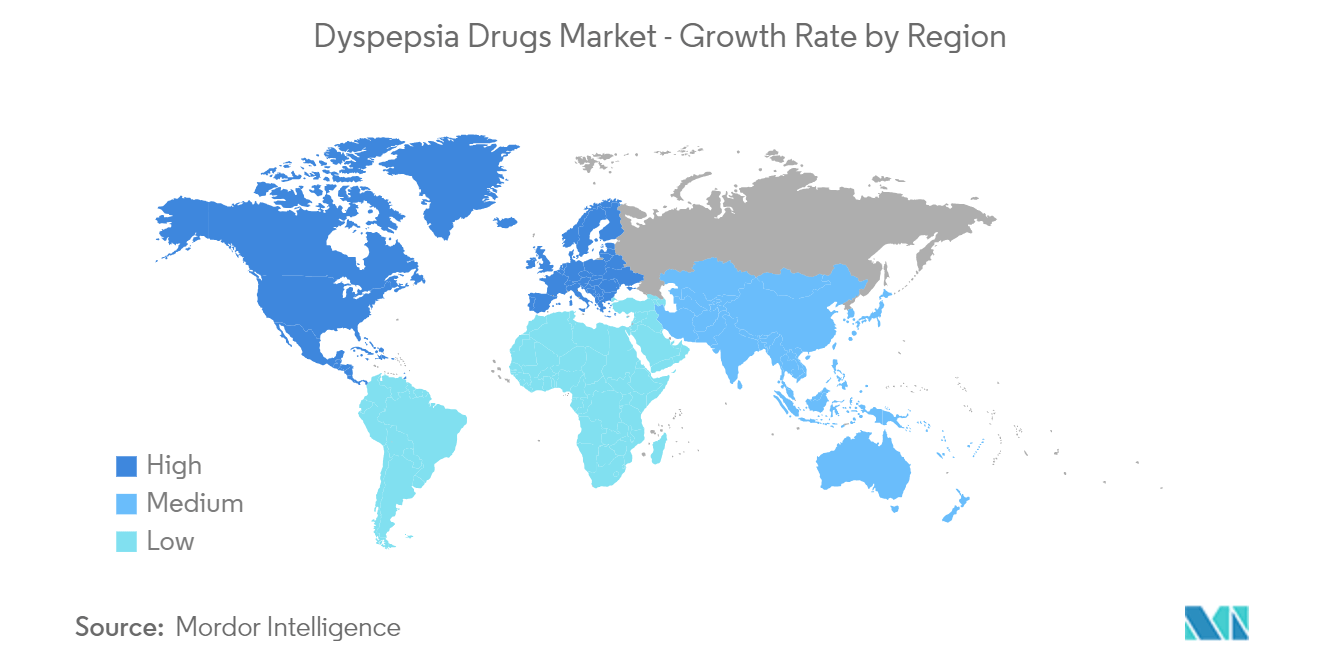
Dyspepsia Drugs Industry Overview
The dyspepsia drugs market is semi-consolidated due to the presence of several companies operating globally and regionally. The competitive landscape includes analyzing a few international and local companies with major or significant market shares. Some key market players are Astellas Pharma Inc., Eisai Co. Ltd, Lupin, Dr. Reddy’s Laboratories Ltd, Glenmark Pharmaceuticals, Takeda Pharmaceutical Company, Novartis AG, Abbott Laboratories, Sanofi, Bayer AG, and AstraZeneca.
Dyspepsia Drugs Market Leaders
-
Eisai Co., Ltd.
-
Novartis AG
-
Sanofi
-
AstraZeneca
-
Lupin
*Disclaimer: Major Players sorted in no particular order
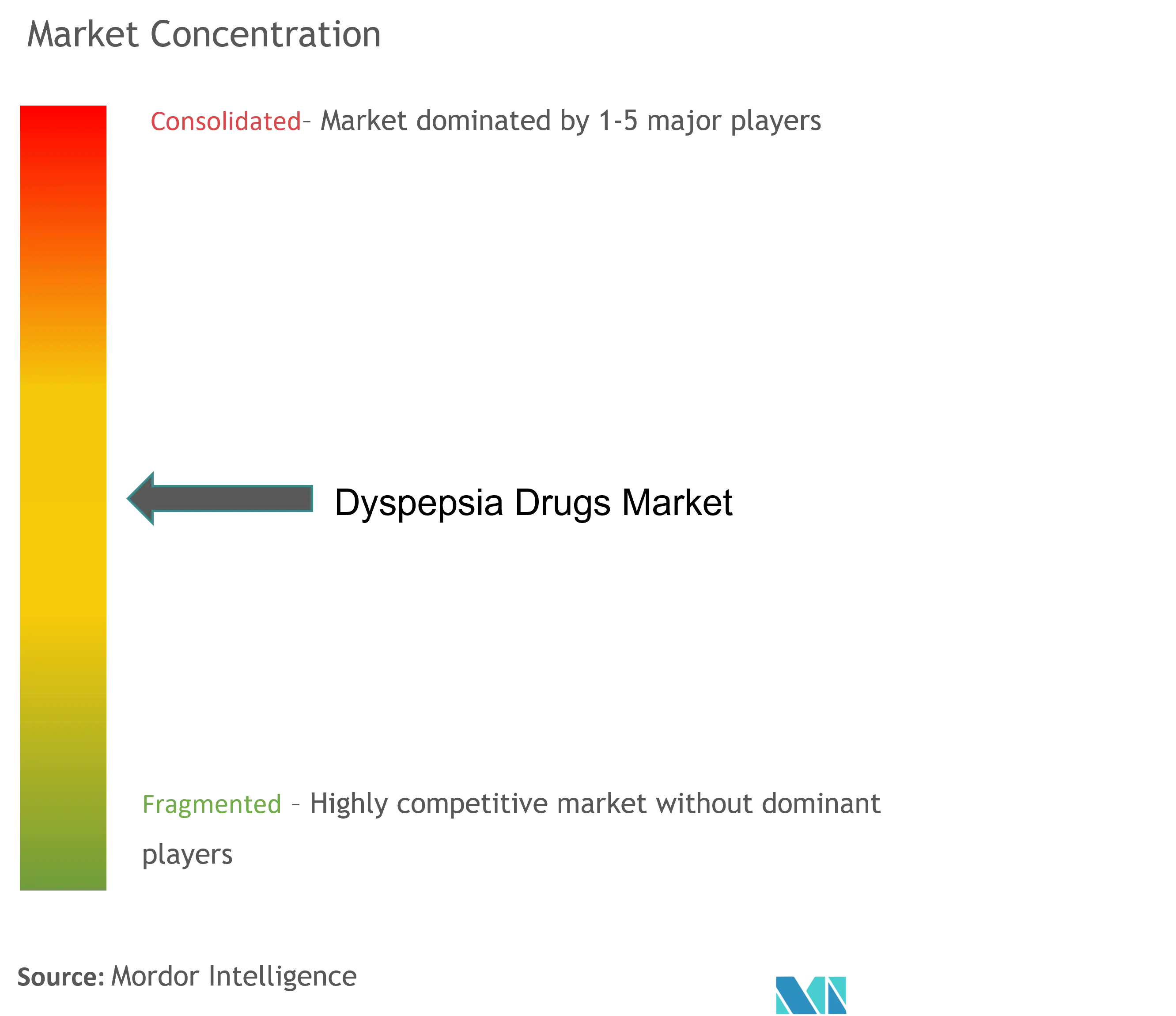
Dyspepsia Drugs Market News
- June 2024: Zeria Pharmaceutical Co. Ltd and Agastra-Lab signed an exclusive agreement on the development and market access of acotiamide hydrochloride hydrate, which Zeria Pharmaceutical discovered as a treatment for functional dyspepsia (FD) in Europe, the United States, and Canada.
- May 2024: Chula Medicine collaborated with the Department of Thai Traditional and Alternative Medicine to determine the curcumin pill to be marketed under ThaiCureMin as an effective treatment for dyspepsia as a modern antacid.
Dyspepsia Drugs Market Report - Table of Contents
1. INTRODUCTION
1.1 Study Assumptions and Market Definition
1.2 Scope of the Study
2. RESEARCH METHODOLOGY
3. EXECUTIVE SUMMARY
4. MARKET DYNAMICS
4.1 Market Overview
4.2 Market Drivers
4.2.1 Rising Cases of Indigestion and Dyspepsia
4.2.2 Poor Lifestyle Choices Leading to Higher Incidences of Acidity
4.3 Market Restraints
4.3.1 Side Effects Associated with the Dyspepsia Drugs
4.4 Porter's Five Force Analysis
4.4.1 Threat of New Entrants
4.4.2 Bargaining Power of Buyers/Consumers
4.4.3 Bargaining Power of Suppliers
4.4.4 Threat of Substitute Products
4.4.5 Intensity of Competitive Rivalry
5. MARKET SEGMENTATION (Market Size by Value - USD)
5.1 By Drug Class
5.1.1 Antacids
5.1.2 Proton Pump Inhibitor
5.1.3 H2 Antagonist
5.1.4 Antibiotics
5.1.5 Other Drug Classes
5.2 By Route of Administration
5.2.1 Oral
5.2.2 Injectable
5.3 By Distribution Channel
5.3.1 Online Pharmacy
5.3.2 Retail Pharmacy
5.3.3 Other Distribution Channels
5.4 Geography
5.4.1 North America
5.4.1.1 United States
5.4.1.2 Canada
5.4.1.3 Mexico
5.4.2 Europe
5.4.2.1 Germany
5.4.2.2 United Kingdom
5.4.2.3 France
5.4.2.4 Italy
5.4.2.5 Spain
5.4.2.6 Rest of Europe
5.4.3 Asia-Pacific
5.4.3.1 China
5.4.3.2 Japan
5.4.3.3 India
5.4.3.4 Australia
5.4.3.5 South Korea
5.4.3.6 Rest of Asia-Pacific
5.4.4 Middle East and Africa
5.4.4.1 GCC
5.4.4.2 South Africa
5.4.4.3 Rest of Middle East and Africa
5.4.5 South America
5.4.5.1 Brazil
5.4.5.2 Argentina
5.4.5.3 Rest of South America
6. COMPETITIVE LANDSCAPE
6.1 Company Profiles
6.1.1 Astellas Pharma Inc.
6.1.2 Eisai Co. Ltd
6.1.3 Lupin
6.1.4 Dr. Reddy's Laboratories Ltd
6.1.5 Glenmark Pharmaceuticals Ltd
6.1.6 Takeda Pharmaceutical Company Limited
6.1.7 Novartis AG
6.1.8 Abbott Laboratories
6.1.9 Sanofi
6.1.10 Bayer AG
6.1.11 AstraZeneca
- *List Not Exhaustive
7. MARKET OPPORTUNITIES AND FUTURE TRENDS
Dyspepsia Drugs Industry Segmentation
As per the scope of the report, dyspepsia refers to indigestion or upset stomach that causes discomfort in the upper abdomen and leads to abdominal pain. Gastritis, peptic ulcers, gallstones, stomach cancer, constipation, and intestinal ischemia are gastrointestinal causes of dyspepsia. Diabetes, thyroid disorders, kidney problems, and the use of nonsteroidal anti-inflammatory drugs (NSAIDs such as ibuprofen) are examples of non-gastrointestinal causes. The dyspepsia drug market is segmented by drug class into antacids, proton pump inhibitors, H2 antagonists, antibiotics, and other drug classes. By route of administration, the market is segmented into oral and injectable. By distribution channel, the market is segmented into online pharmacy, retail pharmacy, and other distribution. By geography, the market is segmented into North America, Europe, Asia-Pacific, the Middle East and Africa, and South America. The market report also offers the market size and forecasts for 17 countries across the region. The report offers the value (USD) for the above segments.
| By Drug Class | |
| Antacids | |
| Proton Pump Inhibitor | |
| H2 Antagonist | |
| Antibiotics | |
| Other Drug Classes |
| By Route of Administration | |
| Oral | |
| Injectable |
| By Distribution Channel | |
| Online Pharmacy | |
| Retail Pharmacy | |
| Other Distribution Channels |
| Geography | ||||||||
| ||||||||
| ||||||||
| ||||||||
| ||||||||
|
Dyspepsia Drugs Market Research FAQs
How big is the Dyspepsia Drugs Market?
The Dyspepsia Drugs Market size is expected to reach USD 10.15 billion in 2024 and grow at a CAGR of 4.46% to reach USD 12.63 billion by 2029.
What is the current Dyspepsia Drugs Market size?
In 2024, the Dyspepsia Drugs Market size is expected to reach USD 10.15 billion.
Who are the key players in Dyspepsia Drugs Market?
Eisai Co., Ltd., Novartis AG, Sanofi, AstraZeneca and Lupin are the major companies operating in the Dyspepsia Drugs Market.
Which is the fastest growing region in Dyspepsia Drugs Market?
Asia-Pacific is estimated to grow at the highest CAGR over the forecast period (2024-2029).
Which region has the biggest share in Dyspepsia Drugs Market?
In 2024, the North America accounts for the largest market share in Dyspepsia Drugs Market.
What years does this Dyspepsia Drugs Market cover, and what was the market size in 2023?
In 2023, the Dyspepsia Drugs Market size was estimated at USD 9.70 billion. The report covers the Dyspepsia Drugs Market historical market size for years: 2019, 2020, 2021, 2022 and 2023. The report also forecasts the Dyspepsia Drugs Market size for years: 2024, 2025, 2026, 2027, 2028 and 2029.
Dyspepsia Drugs Industry Report
Statistics for the 2024 Dyspepsia Drugs market share, size and revenue growth rate, created by Mordor Intelligence™ Industry Reports. Dyspepsia Drugs analysis includes a market forecast outlook for 2024 to 2029 and historical overview. Get a sample of this industry analysis as a free report PDF download.



